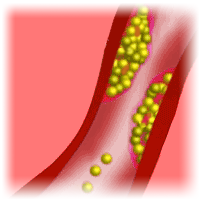
Atherosclerosis is a disease of the blood vessels, which, despite common misconceptions, affects the entire vascular system, not just a certain part of it. Surely, atherosclerosis of cerebral or limb vessels has its own characteristic symptoms and consequences, but the disease is always the same in its nature. It is caused by a disturbance in the lipid exchange and depositing of cholesterol and other lipoproteins on the walls of the arteries. Depositing of such plaques entails stenosis (local manifestation) and may clog the arteries—after which blood won't be able to deliver oxygen and nutrients to some areas of the body. Unlike stenosis, atherosclerosis is a more global process and affects the most part of the vascular system; it is often congenital.
Stenotic atherosclerosis can be extremely dangerous, for in most cases it leads to manifestations such as heart attack, stroke, heart failure, etc. According to the recent findings, the mortality rate from cardiovascular disease is over 50% in Russia. To compare, this rate is four times lower in Europe and Japan.
Most frequently, acute manifestations of atherosclerosis are caused by the lifestyle rather than quality of medical aid. People usually start seeking medical help at stages when their disease can barely be treated because of severe vascular lesion. Treatment of atherosclerosis is usually difficult and lengthy. This is why it's especially important to live a healthy life and regularly check the vascular system state.
What can lead to atherosclerosis?
- Sedentary lifestyle (you need to move more)
- Smoking
- Increased pressure (systolic over 190, diastolic over 90)
- Diabetes
- Obesity
- Emotional and psychological stress
- Unhealthy nutrition (fatty food, cholesterol, etc.)
- Alcohol abuse (taking small doses of alcohol may be good)
How to diagnose atherosclerosis?
There are therapeutic diagnostic methods, such as detecting signs of premature aging and heart and circulatory disease, detecting clots in blood vessels, etc.
Another group of methods is chemical methods—lipid and cholesterol blood tests.
Deeper methods include organ ultrasounds, organ X-rays, and arterial scans.
Progression of atherosclerosis ultimately causes vascular wall stiffness. This fact allows carrying out angioscanning—i.e., vascular wall stiffness tests.



